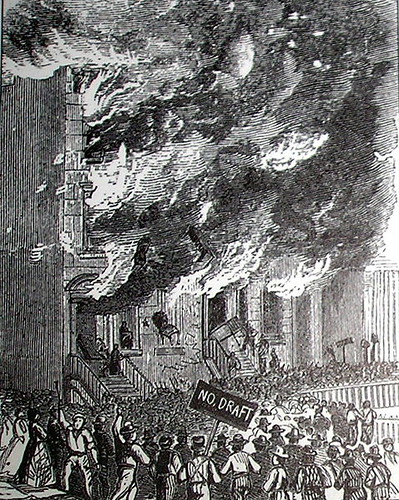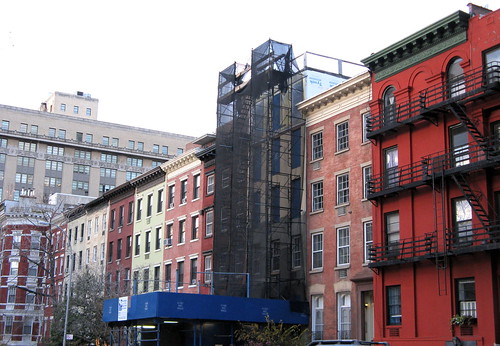On July 13, 1863, Chief Engineer John Decker of the New York City Volunteer Fire Department stood before a mob that had ransacked a building and were now intent on setting it afire. It was known as the Colored Orphan Asylum, a refuge for hundreds of black children located on Fifth Avenue between 42nd and 43rd streets. As the rioters set fire to the first floor, Decker scattered the burning pieces and extinguished the flames. The second time the crowd started a blaze in three different places, and Decker and half a dozen others snuffed out the “incendiaries,” as Harper’s Weekly said in its account. The mob became even more incensed.
Still, Decker wouldn’t give up. Despite threats to his life, he pleaded with the angry crowd “to do nothing so disgraceful to humanity as to burn a benevolent institution,” recounted Harper’s Weekly. Those bent on destruction, however, didn’t stop and soon struck up fires that engulfed the entire asylum, burning it to the ground. The asylum’s matron and others led out some 233 children, who somehow escaped with their lives.
Hundreds of miles from the Civil War’s battlefields, with their bloody fighting and horrid scenes of death, New York City 150 years ago this week suffered days of violence, death, and destruction in its neighborhoods. The Draft Riots of July, 1863, first erupted as a protest of Union Army conscription but exploded and then encapsulated so much more – class division and warfare, racism, immigrant unrest, and workers’ grievances. Whatever had been seething for many years spilled over as crowds attacked other citizens, set fire to public buildings and houses, and made scapegoats especially of black residents and those who sought to end slavery. After four days of rioting from July 13-16, federal troops brought order to the terrorized city. When it was through, an estimated 119 people had died (though some put the toll much higher). The rioters lynched 11 black men. The unrest drove hundreds of thousands of black residents from the city and left many buildings destroyed.
This illustration shows a building on fire on New York’s Lexington Avenue. The drawing appeared in William J. Bradley’s The Civil War: Fort Sumter to Appomattox.
This is a history that many do not know today. Because those in New York City construct, tear down, build again, demolish, and alter the built environment through the generations, it can be difficult to envision these streets as a place where the destruction of those days in the Civil War took place. However, the history is there, in various corners, houses, illustrations, and accounts that make what occurred in the Draft Riots visible and real.
Where the Rioting Began
The first day of the draft, July 11, went off without any disturbance. Yet opposition to the draft was strong. For one, in March, 1863, when Congress established for the first time a federally mandated draft, the measure released men who could find a substitute or pay $300 for a waiver. This action meant the well-off could avoid the draft, yet another injustice that working people faced at a time when the Civil War exacerbated rough economic conditions in the city.
The next day, July 12, men and women opposed to it gathered in the streets and other public places to discuss and formulate resistance. Early on a hot, humid Monday morning, July 13, 1863, hundreds of workers from the city’s railroad companies, iron foundries, and various workshops amassed and marched in the streets. Ultimately, a huge crowd converged at the U.S. Provost Marshall’s Office, at the corner of Third Avenue and 46th Street in Manhattan, where officials were set to choose names for the next Union Army conscripts. Suddenly, the crowd attacked with stones and clubs, rushed into the building, sacked the office, and demolished a lottery wheel and other equipment.
A Mindfulwalker.com essay describes the disturbance, the ensuing riots, and the underlying causes:
The Place Where New York’s Draft Riots Erupted
A Rooftop of Escape
In all of New York City, it’s the relatively unusual block that has survived intact from the 19th century and it’s even rarer still if the place played an important role in the days leading up to the Civil War and during the Draft Riots. The 12 row houses from 333-355 West 29th St., between Eighth and Ninth Avenues, are such a place. They have amazingly survived the cycles of building and destruction around them in Midtown Manhattan. In 2009, the New York City Landmarks Preservation Commission designated these row houses as a historic district, according them protection, in large part due to the hard-fought campaign of two activists, Fern Luskin and Julie Finch, and a group of caring citizens.
When you stand before 339 West 29th St., you’re looking at a place where the divisions between opposing sides in the Civil War played out. Abigail Hopper Gibbons, known as Abby, and her husband, James Sloan Gibbons, who were abolitionists inspired by their Quaker faith, lived at 339 for a time. Here, they sheltered a number of African-American slaves who were escaping northward to Canada. The Hopper-Gibbons’ house was a meeting place for abolitionists.
During the draft disturbances, the rioting crowds especially targeted black residents and fellow citizens who opposed slavery. Thus, the Gibbons and their home became vulnerable during the Draft Riots. An angry mob ransacked 339 West 29th St., and, using torches, set fire to the row house. Two of the Gibbons daughters fled over neighboring rooftops to safety, and a family friend helped them escape.
Though the LPC designated the row houses as landmarks, the Hopper-Gibbons house’s history and integrity remain in danger. Earlier this month, Curbed NY cited the house in its list of 10 New York places facing preservation battles. Four years after the landmarks panel accorded protection to the block known as Lamartine Place, the owner of 339 West 29th St. reportedly is still seeking to keep the penthouse he started to build in 2007 atop the four-floor building – over the very roofline where the Gibbons family members fled for safety.
This 2010 photo shows the 19th century row houses of Lamartine Place, with a penthouse addition on top of 339 W. 29th St.
Explore the history of the family and the house, the Draft Riots incident, and Luskin’s and Finch’s fight to preserve it in:
Sparks Over an Underground Railroad Site
Lamartine Place: Saved for Posterity
Mindfulwalker.com closely examined the controversy over the penthouse floor that the owner constructed on top of the Hopper-Gibbons house in:
Order Unheeded at Underground RR Home
The Accounts of the Day
In its history of publication from 1857 to 1916, Harper’s Weekly termed itself “A Journal of Civilization.” When its illustrators and writers provided accounts of New York’s Draft Riots, they were documenting how civilization had broken down, much as they did when they captured images of battles in the war-torn nation.
Harper’s Weekly was one of various pictorial publications that covered the Draft Riots, and online collections make these reports accessible today. A site called “The Civil War” – http://www.sonofthesouth.net/ – contains a collection of Harper’s Weekly pages on the Draft Riots. In these pages, in the days before widespread use of photography and real-time video, illustrations allow one to see the physical reality of mayhem and destruction on New York’s streets, from the burning of the orphans’ asylum to the lynching of a black man on Clarkson Street.
Tangible Evidence
This summer, the New-York Historical Society is featuring a rotating display of all 50 objects from the newly published book The Civil War in 50 Objects, by author Harold Holzer and the society. The society’s library display includes a Bible from the Colored Orphan Asylum, and a surviving wooden wheel that officials used to pick names for the draft is part of the exhibit. Both are powerful pieces of physical evidence.
Still, it’s a shame beyond words that New York City lacks the historical markers that tell the location and key events of those dark July days in 1863. Many who walk these particular streets are unlikely to know that 150 years ago the Civil War’s divisions and the era’s difficulties burst into the open in these violent riots. What we do not know or we forget about the past surely impairs our understanding of the present and our actions in the future.





No Comments so far ↓
There are no comments yet...Kick things off by filling out the form below.